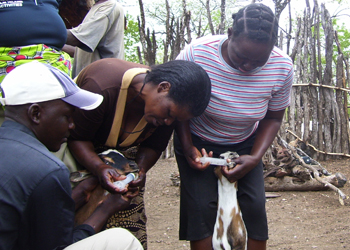Story and Ezekiel Takawira and Everlisto Taruvinga | Project Field Officers | Heifer Zimbabwe
Photo by Heifer Zimbabwe Staff
 Zimbabwe's Chiredzi District is predominantly home to the Tshangani-speaking population, a minority whose main source of livelihood is livestock production, with a small amount of grain production playing a complementary role toward their economic sustainability. The district borders Gonarezhou National Park, one of the largest parks in the country, and is characterized by hot, dry weather conditions with extremely low rainfall.
Zimbabwe's Chiredzi District is predominantly home to the Tshangani-speaking population, a minority whose main source of livelihood is livestock production, with a small amount of grain production playing a complementary role toward their economic sustainability. The district borders Gonarezhou National Park, one of the largest parks in the country, and is characterized by hot, dry weather conditions with extremely low rainfall.
Like most rural areas bordering South Africa, Mozambique and Botswana, productive men from Chiredzi typically migrate across the borders to eke out a living. There is grinding poverty here, and the women have been left to look after their families in very trying and difficult circumstances. The Small Livestock for Household Wealth Creation project was started with the hope of increasing resilience and income source options.
The project has a training component for Community Animal Health Workers (CAHWs), which is designed to equip project members with skills in animal health and management to help in livestock disease surveillance and treatment. Since the project’s inception, Heifer has trained 80 CAHWs, of which 60 percent are women. This training comes in handy in the Chiredzi District, which has a record high number of livestock disease outbreaks because of the close proximity to wildlife.
Heifer has an affirmative approach to increase the capacities of women in this particular area of the country. This initiative to engage the Tshangani women was necessitated by gender analysis research completed by various institutions, including the University of Zimbabwe. The research revealed that the Tshangani people’s wealth potential was handicapped by traditional gender-insensitive perceptions, which relegated women to the periphery of productive sectors, including those of animal health and management. It was observed that women were left at home to look after their families, property and livestock when their husbands and young boys migrated to neighboring countries in search of a living. Women were said to spend most of their productive time herding cattle, although knitting also was a common activity.
Because 70 percent of the project members are women, the resolution to directly involve and recruit more women into the CAHW workshop was highly justifiable. With a livestock mortality rate of between 10 percent and 12 percent in Chiredzi, families commonly experienced big livestock losses. Heifer’s efforts have reduced mortality rates in project communities to 3 percent and below. Relieved, the women in the project are grateful for the benefits that have come from the project and the enlightenment given to and for women. Female CAHWs have taken center stage; they initiate livestock disease surveillance and treatment and engage other women in animal health and management trainings. Where once the culture did not allow women to stand and talk at gatherings, female CAHWs now have the opportunity to speak about issues that relate to animal health.
The trained women can now dehorn, castrate, brand, vaccinate and dose livestock, and the men admire their bravery and confidence. Women CAHWs complete their duties with respect, riding bicycles in and around communities to help other women save their livestock. The enthusiasm and passion for their newly attained expertise is a source of pride for the entire community. Most importantly, the women’s determined efforts have resulted in a significant drop in animal mortalities. This achievement is a testimony to the commitment exhibited by the women during the trainings. This has opened doors for the marginalized Tshangani women, who are now asking Heifer to train and equip even more women.
One CAHW said, “Hail to Heifer for breaking the ceiling, a traditional barrier which barred women from participating in animal health issues.”
At the close of a CAHW workshop, Zava Mpapa, resident chief and project beneficiary, said, “The active participation of these women has triggered an unprecedented demand for Community Animal Health Worker workshops from groups and individuals outside Heifer International projects.” He expressed sincere hope that more and more women could be empowered through this noble idea, which narrows a gap that government was trying to fill with its limited personnel to reduce livestock mortality.
The three-year Small Livestock for Household Wealth Creation project is being implemented in Chiredzi District from July 2010 to June 2013, with an original aim to assist 960 families, 300 through original placements of livestock and 660 through Passing on the Gift®, whereby five goats would be distributed to each of 180 families and 120 families would receive 10 indigenous poultry (chickens and guinea fowl) each. During the first and second years of project implementation, however, livestock was purchased for less than budgeted. This savings made it possible to purchase an additional 400 goats for four more groups of 80 families.